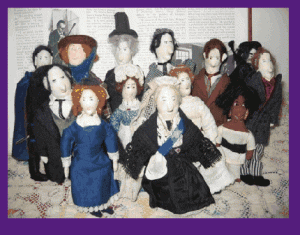Thirteen Characters from the Adventures of Sherlock Holmes
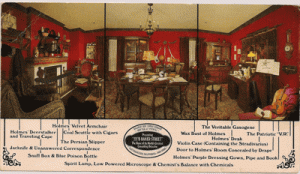 Sherlock Holmes and Doctor Watson have hurriedly left dinner to investigate the details of their latest case. The sitting room at 221B Baker Street remains for your enjoyment and viewing. Located at the Holiday Inn Union Square, Sutter at Powell Streets, S.F.,S. Holmes, Esq. Public House and Drinking Salon offers a Victorian atmosphere, fine spirits, delicate canapes, and an absolutely smashing 30th floor view of San Francisco.
Sherlock Holmes and Doctor Watson have hurriedly left dinner to investigate the details of their latest case. The sitting room at 221B Baker Street remains for your enjoyment and viewing. Located at the Holiday Inn Union Square, Sutter at Powell Streets, S.F.,S. Holmes, Esq. Public House and Drinking Salon offers a Victorian atmosphere, fine spirits, delicate canapes, and an absolutely smashing 30th floor view of San Francisco.From A doll maker’s Notes:
How does Sherlock Holmes stir my imagination? I feel the crisp, punctual beauty of his insight and am touched by his childlike disorder. I came to know him through how well the author describes him. A good writer makes a character seem like a person who really exists, and Arthur Conan Doyle, inventor of one of the most famous of all fictional characters, has certainly done that. We should not be surprised to learn that… at least up until the Second World War… letters requesting the detective services of Sherlock Holmes, were sent to 221 Baker Street in London.
In the early 1980’s I gave a demonstration to teachers and therapists at a Jungian Institute for mentally ill children in Berkeley, California. The idea was to use my character dolls in therapy.
 1. Sherlock Holmes
1. Sherlock Holmes
“But this rose is an extra, it’s smell and color are an embellishment of life, not a condition of it. It is only goodness which gives extras, and so I say agai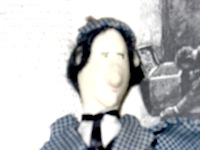 n, we have much to hope from the flowers.” Sherlock Holmes, from The Adventures of the Navel Treaty
n, we have much to hope from the flowers.” Sherlock Holmes, from The Adventures of the Navel Treaty
“We both broke out clapping, as at the well-wrought crises of a play. A flush of color sprang to Holmes’ pale cheeks, and he bowed to us like the master dramatist receiving the homage of his audience. It was at such moments, that for an instant, he ceased to be a reasoning machine, and betrayed his human love for admiration and applause….Dr. Watson
Within the social structure of Victorian England, Conan Doyle created in Sherlock Holmes, a personality, a profession, and a new approach to crime. In forensic medicine, the fruits of a wide acquaintance with the newly emerging scientific disciplines of chemistry, biology, botany, psychology, and anthropology, Holmes and Watson were to combine their talents. Their contemporaries in Scotland Yard are shown to have less education, social position, or talented imagination (Scotland Yard is exemplified by the character, Lestrade). Holmes seems to have earned enough in the services of well-placed clients, to take on only a few cases, and still retire at a comparatively young age, to the country and his bees. His wits unimpaired, many believe his talents were called upon again and again by the grateful men who guided England’s government.
According to “I, Sherlock Holmes…**the great detective was born on January 6, 1854, the descendent of country squires, and grandson of a sister of the French artist Vernet, at the farmstead of Mycroft, near Sigerside, in the north Riding of Yorkshire. (This is nonsense..Fairy Marigold)
Is Holmes still alive? Of course! He is as alive as anything in the Universe, for his image is shared by millions!
He is tall (over six feet), and thin (making him seem even taller). His grey eyes are “sharp and piercing,” his nose, “hawklike.” His hair and thick eyebrows are “black in a narrow forehead.” The Sydney Paget illustrations show us a reasonably well-dressed man, if not always the height of fashion. The clothes and a university-educated accent placed him for his contemporaries. The Holmes personality is dual: “extreme exactness, and poetic contemplativeness; extreme langour and devouring energy.” He was possessed of a “catlike love of cleanliness, and a chin as smooth as linen,” and untidy; “cigars in the coal scuttle and tobacco in the end of his Persian slipper. His fingers were perpetually stained with ink, chemicals and tobacco.”
Holmes is an unsocialable character, discouraging visitors, and he was certainly not a ladies man. His habits are frugal and austere, and he often fasts to increase his mental powers. He has a robust sense of humor and can “laugh to the point of choking,” although is sometimes possessed of the darkest of moods.” “Capable of sensitivity at the appropriate time and place, he is a brain.”
**I, Sherlock Holmes, by Michael Harrison. Memoirs of the late consulting private detective-in-ordinary, to their majesties Queen Victoria, King Edward VII, and King George V.
Favorite Quotes from the great detective:
“See the value of imagination.”
“The vital essence is in the details.”
“Some touch of the artist wells up in me and calls instantly for a well-staged performance.”
“I never can resist a touch of the dramatic.”
“Like all great artists, he was easily impressed by his surroundings.”
“A certain selection or descretion must be used in producing a realistic affect.
“This great somber stage……”
2. Doctor Watson
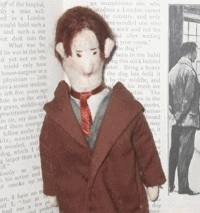 Born under the sign of Cancer, he has recently been celebrated for his 185th birthday!
Born under the sign of Cancer, he has recently been celebrated for his 185th birthday!“Cut out the poetry, Watson.” (From I, Sherlock) John Hamish Watson was born July 7,1852. He began studying medicine when he was only seventeen. He first met Holmes in March of 1881 0r 1882. He chose a military career upon completion of his medical studies, probably for economic reasons. After serving in the Northwestern frontier of India, he was mustered out with a wound and a pension, and took up with Holmes after his return to England. Neither had much money, and were pleased with the modest lodgings afforded by Mrs. Hudson. Less intellectual than Holmes, Watson enjoyed good food and drink, the races, the society of women, and the adventuresome life as Holmes’ partner. Eventually he married well, and between the success in his practise and the proceeds from the publication of his experience with Sherlock Holmes, he undoubtedly rose to fame and fortune.
He was a “middle-aged, strongly built man, possessing a strong jaw, a thick neck, and a modest mustache.” (I, Sherlock) His good looks and romantic nature made him a favorite with the ladies. He must have had brown hair and eyes, to compliment his “earthy” nature.
As a sociable sort, even though Holmes was his closest friend, Watson appears to have been more careful with his attire and conventional in his taste. Men like Watson have raised British gentlemen and their tailors to a position of world esteem in men’s fashion; quality without vulgarity, style without ostentation, complimented by the finest wool and tailoring.
In this personality, we observe “slowness of mind, pretense, belied by an acute sense of the essentials, as by excellent literary abilities. He is lazy; “I am the most incurably lazy fellow that ever stood in shoe leather,” has a quick temper, a poor memory, and is financially irresponsible. His experience with women is said to extend over many nations and three separate continents.
Holmes was all he had, there were no other close friends or relatives in England. “I was nearer to him (Holmes) than anyone else.” The great detective delighted in his pawky humor; “It struck me as being a little out of common.” Holmes found much to admire in him. “Speaking of my old friend and biographer…If I burden myself with a companion in my various idle inquiries, it is not done out of sentiment or caprice, but it is that Watson has some remarkable characteristics of his own, to which, in his modesty, he has given small attention amid his exaggerated estimates of my own performance.”
Watson is surely a romantic, a bon vivant, exhibiting freshness, enthusiasm, humor (however pawkish), and desire for color in life.
Quotes from Dr. Watson: “You have attempted to tinge it with romanticism, which produces much the same effect as if you worked a love story or elopement into the Fifth Proposition of Euclid.”
“I suppose, Watson, that we must look upon you as a man of letters.”
“Your fatal habit of looking at everything from the point of view of a story.”
“You have erred, perhaps, in attempting to put color and life into each of your statements.”
3. Irene Adler
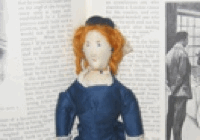 “That woman,” as Holmes always referred to her, was said to have been born in New Jersey in 1858. Well known as an operatic singer of contralto voice and as an “adventuress,” she is also known to have beaten Holmes in the famous Scandal in Bohemia case. She had in her possession a photograph potentially compromising to this royal ndividual, and Holmes was, in spite of an elaborate plan, unable to retrieve it. This beautiful woman (“the daintiest thing under the sun”) was possessed of great intellectual ability, musical talent, and a “soul of steel.” She sang at La Scala and was prima donna of the imperial opera of Warsaw. Adler married Godfrey Norton after the incident of the photograph. (Unfortunatelly, he turned out to be a cad.) Some believe Irene Adler had many secret meetings with Holmes. There is also the belief among some of the hard core Sherlockians, that she was simply another disguise. Sherlock Holmes met Irene Adler when she was thirty and he 34. Then, as now, the female type of sex appeal was youthful, vivacious, and passionate. We may believe however, that a slightly more ample figure was in fashion. Miss Adler’s elegant wardrobe was Parisian, of the Continent. rather than from London shops as she was, due to her profession, an inveterate traveler.At the time she is introduced, she is at the height of her powers to dazzle and charm, which accounts for her need to acquire wealth and social standing so long as she retains her good looks. Her turnout reflects sophistication, presence, the use of cosmetics, and the wily arts of seduction.. The line between the socially acceptible upper crust and the demi-mondaine was preachable in practise, if one had wit and beauty, but the “self-made woman” was a rare and distinctly unusual type. Coming from the South of the United States adds to her slightly exotic charm. She was a cosmopolitan figure who did not belong to any particular country. As an incarnation of the archetypal courtesan, she presents one face of the timeless woman.
“That woman,” as Holmes always referred to her, was said to have been born in New Jersey in 1858. Well known as an operatic singer of contralto voice and as an “adventuress,” she is also known to have beaten Holmes in the famous Scandal in Bohemia case. She had in her possession a photograph potentially compromising to this royal ndividual, and Holmes was, in spite of an elaborate plan, unable to retrieve it. This beautiful woman (“the daintiest thing under the sun”) was possessed of great intellectual ability, musical talent, and a “soul of steel.” She sang at La Scala and was prima donna of the imperial opera of Warsaw. Adler married Godfrey Norton after the incident of the photograph. (Unfortunatelly, he turned out to be a cad.) Some believe Irene Adler had many secret meetings with Holmes. There is also the belief among some of the hard core Sherlockians, that she was simply another disguise. Sherlock Holmes met Irene Adler when she was thirty and he 34. Then, as now, the female type of sex appeal was youthful, vivacious, and passionate. We may believe however, that a slightly more ample figure was in fashion. Miss Adler’s elegant wardrobe was Parisian, of the Continent. rather than from London shops as she was, due to her profession, an inveterate traveler.At the time she is introduced, she is at the height of her powers to dazzle and charm, which accounts for her need to acquire wealth and social standing so long as she retains her good looks. Her turnout reflects sophistication, presence, the use of cosmetics, and the wily arts of seduction.. The line between the socially acceptible upper crust and the demi-mondaine was preachable in practise, if one had wit and beauty, but the “self-made woman” was a rare and distinctly unusual type. Coming from the South of the United States adds to her slightly exotic charm. She was a cosmopolitan figure who did not belong to any particular country. As an incarnation of the archetypal courtesan, she presents one face of the timeless woman.
QUOTES “Love is an emotional thing, and whatever is emotional is opposed to that true cold reason which I place above all things.” SH
“I shall never marry, myself, lest I bias my judgement.” SH
“I am not a whole-souled admirer of womenkind.” SH
“I value a woman’s instincts.” SH
“Their most trying trivial action may mean volumes, or their most extraordinary conduct may depend upon a hair pin or a curling tong.” SH
“Womens’ heart and mind are insoluable puzzles to the male.” SH
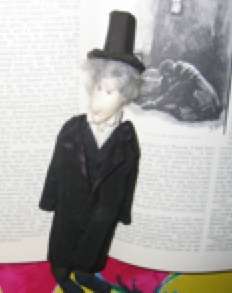 4. Moriority
4. Moriority
“This man is a scholar.”“He sits motionless, like a spider in the center of his web, but the web has a thousand radiations, and he knows well every one of them.”“This foul spider.”
“That great malignant brain..’ Born in 1844 and died in 1891, this fatherly, ecclesiastical, and soft-spoken man, was a villain of unspeakable horror. Extremely tall and thin, with a high domed forehead curving to meet his sparse grey hair, he was both attractive and repellent. His sunken black eyes peered out of a head stuck out and oscillating from side to side like a snake. He was of good birth and excellent education and, although fussy about his clothes, he dressed inconspicuously and was a little blacker in appearance than the commonplace. It was best to go unnoticed in a world preferring to avoid the issue of evil and to “live and let live.” Moriority, of course, encouraged this complacency. Only Holmes was clever enough and of sufficiently high and tenacious of purpose to defeat him.
This mathematician appears to have organized a criminal syndicate in London; associating with the criminal class and bringing his superior wits to the strategy of committing “perfect crimes.”His genius and deductive skills were admired by Holmes who, in turn, was able to defeat him by those same skills in that great battle at Reichenbach. THE FINAL SOLUTION
 5. Mrs. Martha Hudson
5. Mrs. Martha Hudson
She is perhaps the most famous landlady in history. Presumably a widow, she rented rooms and servedmeals with the help of a serving girl or two. I have given her blue eyes and brown hair, and made her a little stocky. (“elderly motherly woman of the buxom landlady type”) She is dressed as she would be, going about her morning work at 221 Baker Street. This lady, known for her “Scotch Breakfast,”stood in awe of Holmes and he, in turn treats her with sensitivity as he did all women. The best account we have of Hudson was penned by Watson in THE DYING DETECTIVE.
“Mrs. Hudson, the landlady of Sherlock Holmes, was a long-suffering woman. Not only was her first floor flat invaded at all hours by throngs of singular and often undesirable characters, but her remarkable lodger showed an eccentricity and irregularily in his life which must have sorely tried her patience. His incredible untidyness, his addiction to music at all hours, his occasional rifle practice within doors, his weird and often malodorous scientific experiments, and the atmosphere of violence and danger which hung around him, made him the very worst tenant in London.”
The Victorian Age saw a considerable rise in the comfort and ease of the suburban middle-class. Ladies like Martha Hudson crowded their houses with a wide assortment of furniture and bric-a-brac in a profusion we would find overpowering. Ladies wore stiff, rather formal, clothes which proclaimed their impregnable virtue. Not only had the industrial revolution brought down the price of fabrics, but the apprenticeship system made finished handmade and elaborately stitched garments of high quality available at a relatively modest cost. Although she was able to overlook Holmes’ many failing as a tenant, we may be sure that she was personally concerned with his appearance, as she was solicitous for his comfort and well-being.
6. Mycroft
Quotes:”Sherlock has all the energy in the family.””Mycroft has his rails, and he runs on them.””In that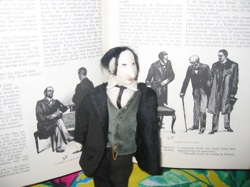 great brain of his, everything is pigeonholed and can be handed out in an instant.””All other men are specialists, but his specialization is omniscience.”
great brain of his, everything is pigeonholed and can be handed out in an instant.””All other men are specialists, but his specialization is omniscience.”
Mycroft Holmes was born in 1845, seven years before his brother, Sherlock. He was a “heavy, massive figure,” with the same high forehead, steel gray alert eyes, and faraway look. He audited books for the government and focused on this work with the same familiar deductive, analytical genius as Sherlock applied to his detective work. Much as we know Sherlock Holmes to have been reclusive and private in his habits, his brother Mycroft managed such a life of discreet anonymity that we know almost nothing about him, despite assurances of his importance, behind the scene, in the politics of the British Empire. Older and stouter than Sherlock, he is probably more careful and less eccentric in matters of dress and appearance. Tall and distinguished, comfortably esconced in the Diogenes Club, he makes his shrewd and unpretentious way through a world of rapid social, economic and technological change. If, in retrospect, we envision the Victorian Age as a placid time, an era of comfort and respectability, this is a tribute to the vigilance and moral exertions of men like Mycroft Holmes who advised the great statesmen and shouldered the burdens of Empire.
The Diogenes Club was a silent place where talking was forbidden and where its members sat in huge easy chairs reading the latest periodicals.
He was consulted many times by his famous brother, who considered Mycroft’s powers of observation even greater than his own. But, because it required physical exertion, Mycroft was reluctant to carry out much in the way of detective work.
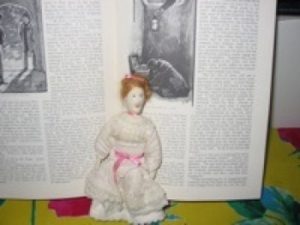 7. Mary Morstan
7. Mary Morstan
Mary Morstan was the daughter of Arthur Morstan, after whose death, in 1892 she consulted Holmes in the Sign of the Four.” Watson describes her at this first meeting: “a plainness and simplicity that suggested limited means.” Her expression, “sweet andamiable;” “eyes blue and hair blonde.” These large blue eyes were “singularly sympathetic and spiritual.” On this occasion she was dressed in a “somber gayish-baige,”but later, her costume is described by Watson:”She was seated by the open window dressed in some sort of diaphonous material, with a little touch of red at the neck and waist.”Pundits argue just when Watson married Mary Morstan, but it was probably within the year following the Golden Jubilee celebration of 1887. Thus the Empire was in its heyday, and such a story of the exotic East, such as The Sign of the Four becomes possible. Nearly a century later, the high-water mark of imperialism seems far-off. Unlike Irene Adler, whose wrdrobe reflectes the haute couture of Paris, we may be sure that Mary’s wardrobe is solidly English and Victorian. She and Watson are from the same social stratus and, like him, her father had served in India. Both reflect the increase in wealth which the days of the Empire afforded the upper-middle classes, but compared with Adler, Mary was rather unsophisticated and uncomplicated as well. Watson admires her for her seemingly uninterest in wealth.It is significant that it is Watson who is drawn to Mary, whereas Holmes is unable to forget Irene. Mary is twenty-seven, that sweet age when youth has lost its self-consciousness and become a little “sobered by experience.” We know that Watson responded to feminine wiles and that Mary evoked this response. Thus, despite their staid English backgrounds, we may confidently suppose both to be glowing with romantic love.
8. Queen Victoria

1819-1901 Queen of Great Britain and Ireland, Empress of India.
She ascended the throne in 1837, upon the death of William 1V, proclaimed Empress of India in 1877. Sherlock Holmes was born in her reign.
The last fifteen years of Victoria’s sixty-four year reign (1837-1901) saw the sunset of her time and nearly all of the adventures of Sherlock Holmes. The two were almost opposites and yet each respected the other. Each possessed a strong measure of honesty, courage, and good will. Victoria’s life concerns events well before Holmes’ career which had shaped the era into which he was eventually born. Victoria was a passionate and clever woman, although deficient in the kind of intellectual wit for which Holmes was so famous, and may be regarded as successfully fullfilling her role as wife and mother as well as Queen and Empress. Surprisingly, in the context of her times, many of her views on social matters were advanced and liberal. She much preferred the unpretentious informality of Highland Scotland to the artificialities of Windsor and London. Combining the business of government and family, she secured marriages for her children and grandchildren with all the important thrones of Europe. Her mourning for her husband, Albert, who died in 1861, and her ample and grandly maternal form, are qualities which determine the costumes of her last years. The ensemble combines to set her off as the icon of the era to which her name is given.
9. King of Bohemia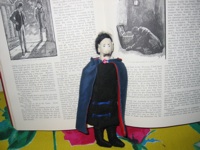
This questionable character was born in 1858, the Grand Duke of Castle-Felstein and hereditary King of Bohemia. Watson describes him as: ” a man hardly less than six feet, six inches in height, with the chest and limbs of a Hercules.” His costume allows the artist an irresistable opportunity for detail and color.”Heavy bands of astrakan were slashed across the sleeves and front of his double-breasted coat, while the deep-blue cloak, which was lined with flame-colored silk and secured with a brooch of single-flaming beryl. Boots, which were trimmed at the top with rich brown fur, completed the impression of opulence.”This hereditary and colorful king seeks help from Holmes to retrieve a photograph of himself and Irene Adler. The outcome of this case was said to affect English History. Nineteenth Century Germany and the rest of continental Europe was a crazy quilt of nations, states, and noble families. By the end of her reign, Queen Victoria had married her children and grandchildren into nearly every one. Thus the business of the British royalty and foreign affairs are intertwined. Like Victoria, our King is passionate, arrogant, self-centered, and determined to preserve honor. In the rapidly changing Europe of the pre-World War 1 period, many forces combined to alter the balance of power centered in hereditary titles and upstart financiers and industrialists. In every friendship lurked the seed of emnity. The grand scale of the king’s style of living is threatened by scandal. Sherlock Holmes gets to meet this character and smooth the path of nations.We may hope that in the twenty-eight years allotted him, before all is to be drenched in blood and swept away by war, this king may learn better to manage his affairs and the politics of Bohemia.
10. The Irregular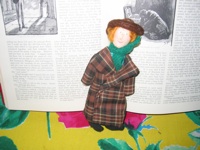
I have chosen to portray an Irregular after the humorous Wheeler from The Mudlark , a popular novel set in Victorian England. This poor waif from the London streets wore a man’s clothing, a coat that reached to the ground and a hat perched above it. Here we have an obscure member of this “small but efficient organization.”Wheeler is an excellent portrait of the late Victorian type, being only five years before the first Sherlock Holmes tale. The street urchin surviving disease and neglect was resourceful enough to acquire cast-off clothing against the awful London weather. He was numerous and common enough to “go everywhere, see everything, and overhear everything.” Organized (“all they wanted was organization”), by Holmes, they were a potent force against crime.England became the most populous nation in Europe in the seventeenth Century. Political, social, and economic dislocation bred a class of landless urban poor, who were often homeless and out of work, and whose children were exploited in factory sweat-shops as the industrial revolution progressed. Despite the social legislation of Disreli’s ministry, many of these youngsters were ill-kempt and uneducated. Others received only the most minimal schooling before being forced into factories or bound into apprenticeships.
11. Inspector Lestrade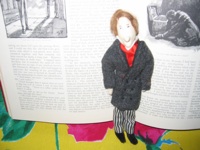
was born in 1844, and served fpr more than forty years on the Metropolitan London Police Force (Scotland Yard) which was created in 1829. He is a Londoner all right. Now (Study in Scarlet c. 1881), “a small sallow red-faced fellow.” Later (Baskerville 1891), “a small wiry bulldog of a man.” Could this be, in that age-spread, a bit of middle-age spread? Illustrations vary as to his features and attire, but he seems to have a special fondness for the pea jacket. Certainly he could be around five foot three or four inches tall.With the passage of time, his standing on the force must have improved and his fortunes and, thenceforth, his wardrobe. The social politics of the man on the force was somewhat in flux, although solid aristocrats were in charge, Doyle did not doubt their inferiority to himself. Lestrade is a foil to Holmes’ wit and brilliance but, nevertheless, he was the “best of the professionals.” He was energetic, tenacious, and patronizing, but Holmes bemoans his conventionality and lack of imagination. Empire and Industrialism combined to raise the standard of living, expectations, and education of the Middle-Classes of Victorian England.
12. Tonga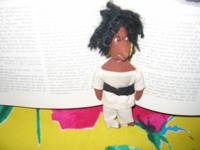
“There is nothing too little.”
Tonga, an Andaman islander, murdered Bartholemew Shotto in The Sign of the Four This ficticious being is the only human Holmes ever shot. This little fellow terrorized shipwrecked crews, braining them with clubs, shooting them with poisoned arrows, and feasting on them. Tonga was found near death by a convict crew and ended up as a companion to them with his only earthly possessions; a bamboo spear, and a coconut mat. Anthropology scarcely existed in the Victorian Era. Tonga is an archetypal savage out of the semi-conscious dreamworld where myth gives new shape to scattered facts and fears. This nimble little savage is ruthlessly cruel, inscrutable most of the time, yet has the makings of a loyal and trusted servant to his European master. Although fully grown, he is diminished in stature and seen as childlike, never to become a man. The portrait tells us more about the author than about the ancient race of Andaman aborigines. Along with the blow gun and a bit of jungle atmosphere, there hovers about him the tang of the Malays and the South China seas, he is a sort of pirate; a shrewd little devil, an uncivilized imp, at once attractive and frightful.
Considering the merciless subjugation of native peoples by the superior technology and mercilous greed of colonial imperialism in the Americas, Asia and Africa throughout the eighteenth and nineteeth Centuries, he combines the fears and perceptions of the enslaver as he views his faceless minions, and dreads lest his newly acquired grip be loosed. In the thralls of Victorian custom and rigidity, the English can, paradoxically, envy the native’s “freedom.” This impossible collection of contradictory traits constitutes the exotic charm, both of Tonga and the Indian and far-Eastern culture, which became fashionable in late-Victorian drawing rooms, Tonga may be conceived by the imagination, but was never meant to reflect the Andaman Islanders or anyone else.
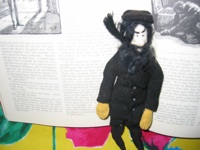
A strict puritan in everyday life, Peter Carey is an old sea-dog. He is patterned after the common literary figure developed from the emergence of England as a sea-faring nation in the Elizabethan Era. However the rogue or pirate on the sea, he was imagined to lead a respectable life in the peaceful sea-side village of Woodman’s Lee.As captain of the “Sea Unicorn” of Dundee in 1833, this fiend terrorized his men and when ashore flogged and brutilized his wife and daughter and even chased after the vicar of that Sussex village. He drank rum to excess, making no improvement on his temperment.He is not just an unscrupulous sea-dog, but an officer and captain turned criminal. He is crafty enough to defraud Neligan’s father and scheme away in his vile mind (Black Peter). Brute strength and violence hold a fascination for men like Peter Carey who embodies contradictions inherent in the far-flung sea- based Empire, combined with the fierce blackness of a storm at sea. “Evil indeed is the man who has not one woman to mourn him.”
